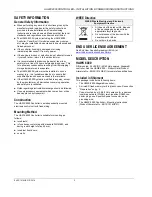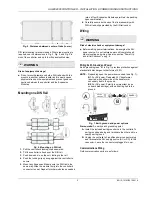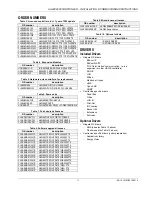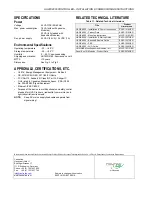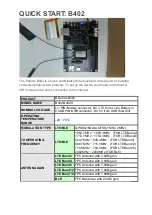
HAWK 8000 CONTROLLER – INSTALLATION & COMMISSIONING INSTRUCTIONS
EN1Z-1016GE51 R0218
8
A-
A+
S
END
BIA
MID
END
BIA
MID
47.5 kOHM
47.5 kOHM
+5V
ISO
GND-A
END
BIA
MID
Fig. 13. RS485-A 3-position bias switch set to MID
The recommended bias switch setting depends upon the
location and usage of the given HAWK 8000. It also depends
upon the selected communication protocol (BACnet MS/TP,
Panel Bus, or Modbus RTU Master communication,
respectively).
NOTE:
All terminals are protected (up to 24 Vac) against
short-circuiting and incorrect wiring – except when
the 3-position bias switch is set to "END," in which
case the terminals of the RS485 bus have no such
protection. Higher voltages may damage the device.
NOTE:
According to BACnet standards, a min. of one and a
max. of two BACnet devices must have its/their bias
resistors switched ON. In the case of the RS485
ports of the HAWK 8000, setting the bias switch to
either "BIAS" or "END" fulfills this requirement.
RS485 Standard
According to the RS485 standard (TIA/EIA-485: "Electrical
Characteristics of Generators and Receivers for Use in
Balanced Digital Multipoint Systems"), only one driver com-
municating via an RS485 port may transmit data at a time.
Further, according to U.L. requirements, each RS485 port
may be loaded with a max. of 32 unit loads. E.g., CentraLine
devices have as little as ¼ unit load each, so that up to 128
devices can be connected.
BACnet MS/TP connections to the RS485 ports must comply
with the aforementioned RS485 standard. Thus, it is re-
commended that each end of every connection be equipped
with one termination resistor having a resistance equal to the
cable impedance (120 Ω / 0.25 – 0.5 W).
RS485 systems frequently lack a separate signal ground wire.
However, the laws of physics still require that a solid ground
connection be provided for in order to ensure error-free
communication between drivers and receivers – unless all of
the devices are electrically isolated and no earth grounding
exists.
IMPORTANT
In the case of new HAWK 8000 controller installations,
we strongly recommend using a separate signal
ground wire. Doing otherwise may possibly lead to
unpredictable behavior if other electrically non-isolated
devices are connected and the potential difference is
too high.
In the case of the installation of HAWK 8000 con-
trollers in already-existent RS485 two-wire systems
(e.g., when replacing PANTHER or LION controllers
with HAWK 8000 controllers), not using a separate
signal ground wire will probably have no undesirable
effects.
The cable length affects the baud rate. The following table
provides a few examples.
Table 2. Baud rate vs. max. cable length for RS485
Baud rate
Max. cable length (L)
9.6 - 76.8 kbps
1200 m
115.2 kbps
1000 m
For information on wire gauge, max. permissible cable length,
possible shielding and grounding requirements, and the max.
number of devices which can be connected to a bus, refer to
standard EIA-485.
Ethernet Wiring
The HAWK 8000 is equipped with two RJ45 10/100-Mbit
Ethernet ports (see Fig. 8). They are labelled PRI (LAN1) for
primary and SEC (LAN2) for secondary. Each port is capable
of up to 100 mbits/sec baud, and uses a standard Ethernet
patch cable for connection to an Ethernet switch.
WARNING
Risk of electric shock or equipment damage!
►
It is prohibited to connect any of the RJ45 sockets of the
HAWK 8000 Controller to a so-called PoE-enabled device
("
P
ower
o
ver
E
thernet").
The factory default IP address for PRI is 192.168.1.140. The
subnet mask is 255.255.255.0. By default, SEC (LAN2) is
disabled.
Please see HAWK 8000 – Installation & Startup Guide
(EN1Z-1027GE51) for details on the software configuration of
the Ethernet ports.
NOTE:
Unless you have a specific application for SEC
(LAN2) – e.g., when using it to isolate a driver's net-
work traffic – generally only PRI (LAN1) is used.
If you wish to enable SEC, note that PRI and SEC
must be connected to different IP subnets. Further,
HAWK 8000 does not provide IP routing or bridging
operation between two Ethernet ports.
Power Up and Initial Checkout
Apply power by inserting the 2-position 24V power connector
plug. See also Fig. 7.
Check the STAT (status) and BEAT (heartbeat) LEDs (Fig.
14).
When power is applied, the green STAT LED will light. This
indicates that the system is OK, with power applied. During
bootup, the BEAT LED may flash at 1 Hz with a 90% ON,
10% OFF duty cycle. When bootup completes, the platform
daemon is started, and the normal 1 Hz flash (50% ON, 50%
OFF) duty cycle of the BEAT LED returns.


